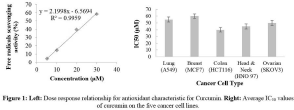Print version
Search Pub Med
- M. A. Baghdadi1
- H. Almosa2
- 3
- Z. Almalki2
- 3
- M. Alqriqri4
- I. Denetiu4
- M. H. Ucisik5
- 6
- S. Damiati2. 1Research Centre
- King Faisal Specialist Hospital & Research Centre
- Jeddah
- Saudi Arabia
- 2Biochemistry
- Faculty of Science
- King Abdulaziz University (KAU)
- Jeddah
- Saudi Arabia
- 3Jamjoom Pharmaceutical
- Jeddah
- Saudi Arabia
- 4King Fahed Medical Research Center
- Jeddah
- Saudi Arabia
- 5Biomedical Engineering
- School of Engineering and Natural Sciences
- Istanbul Medipol University
- Istanbul
- Turkey
- 6Medipol Regenerative and Restorative Medicine Research Center (REMER)
- Istanbul
- Turkey
| 007P Edinburgh, United Kingdom Pharmacology Futures 2018 – celebrating 250 years of pharmacology in Edinburgh |
The anti-cancer and anti-inflammatory effects of curcumin in multiple human cancer cells
Introduction: Curcumin (Diferuloylmethane) has received widespread interest for its therapeutic effects, including antioxidant, antiseptic, anti-bacterial, anti-inflammatory, anti-cancer, and analgesic. It is an active polyphenol isolated from the Curcuma longa plant that has been used for centuries as a spice and as a dietary supplement, and considered pharmacologically safe -2. Since curcumin showed a valuable potential against several cancers, this study aimed to analyze the cytotoxic effects of curcumin in multiple cancer cells (lung, breast, colon, head and neck, and ovarian) and its effect on the production of pro- and anti-inflammatory cytokines (for example, TNF-α and IL-10).
Method: Cell-free system for antioxidant assessment (DPPH), cell cytotoxicity (WST-1), apoptosis (Annexin) and cytokine release (ELISA) assays were carried out to investigate the effects of curcumin on cancer cells and compared to the same untreated cell lines.
Results: Free radicals scavenging activity of the curcumin was determined as a function of increasing curcumin concentration. The low IC50 value correlated directly to the Curcumin antioxidant properties. Determination of the in vitro cell viability/cytotoxicity to curcumin at 24h on the selected cancer cell lines showed different responses with varying IC50 concentrations. Cytokines released by different cell lines were measured by ELISA after 72h. The obtained results showed that not all cell culture medium contain measurable TNF-α (e.g. head and neck cancer cell lines), whereas other cancer cells reproducibly released different detectable levels of TNF-α and IL-10. However, the correlations between apoptosis and TNF-α were also different among the cancer cell lines.
Conclusion: The potential anti-cancer and anti-inflammatory effects of curcumin were studied in multiple human cancer cell lines. The obtained results showed that the various cancer cell lines do not respond in a similar fashion to curcumin treatment, which may be attributed to the drug-resistant cell lines used. However, these data could be exploited to assess how different tumors are likely respond to new drugs. Furthermore, they can be useful to study combination therapy, with the ability to improve the success rate for developing new effective personalized cancer therapy.
Funding: This work was supported by the Deanship of Scientific Research, King Abdulaziz University, Jeddah, SA. Grant no. G-208-247-38 to Dr. Samar Damiati.
References
1. Wilken R et al. (2011). Mol Cancer 10: 12
2. Ahmed M et al. (2013). Molecules 18:1483-1501
3. Kulbe H et al. (2007). Cancer Res 67: 585-592


